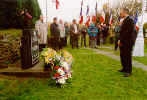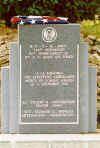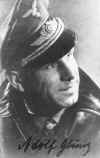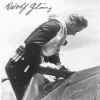|
The Death of
the Black Swan
by Verne Woods -
91st BG
|
A week or so before the December 31,
1943, mission, my crew, the Mendelsohn crew (see photo below), was breaking apart. Our navigator, Bill Borellis, was promoted to the exalted position of 91st Bomb Group navigator; our bombardier, Harold Fox,
(later to be killed in action over Hamburg) had applied for
special training as a navigator and was leaving the crew, and the
pilot, Stuart Mendelsohn, had been designated, but not yet
officially installed, as the new operations officer of the 324th
squadron. And I had just been checked out as first pilot and was
about to take over what remained of our original crew.
As the 324th operations officer
designate, Stuart spent his evenings in the squadron headquarters
office, and I usually dropped in on him to see what was cooking
for the next day. On the night of December 30, 1943, I found him
scheduling crews for the next day's mission. When I walked into
the office, he looked up and said, "I don't have a co-pilot
for you yet. Do you mind if I go along with you as your
co-pilot?" So that's how Stuart came to occupy the right seat
during the mission. The psychology of our reversed roles would
have been awkward except for the fact that we were already
accustomed to shared decision-making so nothing was really
different.
The December 31, 1943, mission to the
Bordeaux-Cognac area of France was a long one -- a scheduled
eleven hours from take-off to landing. At the 5:30 a.m. briefing,
we were told that it would be an easy milk run. Because our crew's
regular plane, the Duke of Paducah, was in the hanger for flak
hole repairs, we were assigned a replacement, a B-17F, The Black
Swan.
The mission was flown at 21,000 feet.
Over the Bay of Biscay, a strong tail wind took us to the Bordeaux
area much sooner than expected. That same wind, however, would
greatly retard our trip home. Immediately after crossing the
French coast, we encountered unexpectedly heavy and accurate enemy
flak. A loud and powerful explosion suddenly rocked our
plane sending it careening dangerously close to another B-17. The
flak burst, with its bright orange center, exploded directly above
the right wing, the big black cloud enveloping us momentarily as
we passed through it. Shrapnel tore holes in the aluminum skin
near Mendelsohn but no one was hit. But a moment later the number
three engine froze and we were unable to feather the prop.
Manifold pressure of the number four engine dropped sharply, an
indication that the supercharger on that engine had been damaged
as well. Even at full throttle, we couldn't maintain
altitude.
We fell behind, seeing the formation our 91st Bomb Group B-17s
stream off ahead of us.
We reversed course, turning
northwest back out over the Bay of Biscay. There we opened our
bomb bay doors and released our bombs harmlessly over the water. With greatly compromised engine thrust, we assumed a limping,
solitary, northerly course that we hoped would take us back to
England. Our progress was slowed by a strong head wind. We
estimated that it would take us two hours to reach the Brest
Peninsula. We were still gradually losing altitude and there was
nothing we could do about it. But when we reached the denser
atmosphere at about 14,000 feet our altitude stabilized as we had
hoped it would. Soon afterwards, however, the temperature gauge on
our number one engine began to creep up. We throttled back and as
a result began to lose altitude once again.
The over-heating had resulted from the
extra-lean fuel mixture we'd set for engines one and two in order
to save fuel. A richer fuel/air mixture would lower the engine
temperature, but at the expense of increased fuel consumption. The
combination of the unfeathered prop on engine three and the yawing
to the left due to unbalanced engine thrust had created a heavy,
fuel-depleting drag. We feared that we would have to ditch the
plane in the Bay. Mendelsohn and I debated the wisdom of turning
east again where, if we had to abandon the plane, we could
parachute over dry land. This extreme measure was ruled out
because we knew that at lower altitudes reciprocating engines
(unlike jet engines) are more efficient. Also, in the denser air
of lower altitudes, engine cooling improves and we would then be
able to get more thrust from our over-heating number one engine. It seems implausible, I know, but of all the besetting concerns
facing Mendelsohn and me during that long homeward journey, the
thing I most clearly remember now in retrospect is how Mendelsohn
and I constantly adjusted and fine-tuned the air/fuel ratio of
engine one.
At about 10,000 feet we again stopped
losing altitude. Our concerns over fuel had so absorbed us that we
had given little thought to the 40-minute transit across the Brest
Peninsula and the possibility of a fighter attack awaiting us
there. During the two hours over the Bay, Mendelsohn and I had
ample time to weigh our various options. Should we follow
recommended procedures whereby straggling planes, having left
formation, are to hit the deck -- that is, to fly over enemy
territory at a low altitude where detection and tracking are more
difficult? Or should we maintain our 10,000 feet altitude? Several
considerations led us to decide to remain at that altitude. We
thought it probable that we would run out of fuel somewhere over
the Brest Peninsula. If so, we would need a safety margin of about
a thousand feet if we had to bail out. But the real reason that we
decided to remain at 10,000 feet was because we needed the
altitude cushion. Our crippled B-17 simply wouldn't climb. Once we
lost a bit of altitude, we couldn't, even with the two and a half
engines at full throttle, regain it. Later, of course, I was to
rue the fact that we didn't follow recommended procedures whereby
pilots of straggling planes are instructed to return at tree-top
level.
Finally, we reached the Brest Peninsula.
And immediately we were attacked. In spite of intercom warnings to
the crew to be vigilant, no one saw the two FW-190s until they
appeared suddenly right in front of us. They came from the classic
twelve o'clock high position, in tandem, one after the other. I
saw the exploding 20 mm shells, small black puffs of smoke, before
I saw the two FW-190s -- the black crosses starkly visible on the
underside of their wings as they made a diving split-S turn
directly ahead of us. The FW-190 pilots seemed to be
inexperienced. Both had fired their guns much too early, unlike
the fighter attacks we'd been subjected to over Germany where
pilots held their fire until they almost rammed you. After that
first pass the crew watched (and reported on the intercom) as the
two FW-190s circled back out of range on our right. On their
second frontal pass, they again fired their 20mm cannons
prematurely. Because of this seeming ineptitude, I was beginning
to feel a little more confident that we might escape. Then on the
third pass, the lead FW-190 held fire until the last second. I
knew we were going to get blasted. And we were.
Two or three (maybe more) shells crashed
through the right cockpit window tearing the frame away. Exploding
in the cockpit, the shells killed Mendelsohn instantly. Blood was
spattered everywhere. Seeing it on my jacket and flight gloves, I
thought I was hit, too. The wind coming through the large gap on
the right side of the cockpit was deafening. But the plane itself
seemed to be flyable except that I couldn't correct for a shallow
dive to the left. The rudder seemed locked tight. I pushed the
panic button signaling everybody to leave the plane. At least I
think I did, but I don't remember doing it. I tried to get the
plane straight and level but was unable to correct for the jammed
left rudder. The wind-noise in the cockpit was un believably
shrill, but the engines were running fine. Then, at about 3,000
feet in a moment of sudden panic I decided that I'd better get the
hell out. I switched on the automatic pilot (in accordance with
procedures for abandoning planes) and left the cockpit seat. I was
surprised to see Richard Hensley, the engineer/top-turret-gunner,
still there, sitting on the pedestal of the top turret gun. He
didn't seem to be hurt. I gestured toward the open front escape
hatch from which the bombardier and navigator had already exited. I then picked up a parachute pack to give him, but he refused it.
He acknowledged nothing that I did. Then I realized that the plane
was about to crash at any moment. I snapped on the same parachute
pack I had offered to Hensley and dived through the open hatch.
I pulled the cord, the parachute opened
and the next second I was on the ground on my knees. A hundred or
so yards away, The Black Swan hit the ground at about the same
time. I knew that Mendelsohn and Hensley were in it. Heavy black
smoke soon marked the impact point. Far downwind, still high in
the sky, I counted five parachutes of crew members who had bailed
out earlier. Where were the other two crew members? (They too had
gotten out safely, I would learn much later.) The two FW-190s were
no where in sight.
 EPILOGUE
ONE: The Black Swan crashed into a French farmer's barn in the
small village of Bannalac in Brittany. Fifty five years later, on
October 31, 1998, Yves Carnot, the grandson of the farmer into
whose barn The Black Swan had crashed erected a small granite EPILOGUE
ONE: The Black Swan crashed into a French farmer's barn in the
small village of Bannalac in Brittany. Fifty five years later, on
October 31, 1998, Yves Carnot, the grandson of the farmer into
whose barn The Black Swan had crashed erected a small granite monument in memory of my two crew members who died there. Carnot
sent me a video of the ceremonies which were attended by some 300
people. Included among them was a representative of the American
embassy in Paris. But neither I nor any of the other surviving
crew members was there. Earlier in the year, in May, 1998, Carnot
had visited me and my wife in Lexington, Massachusetts, bringing
with him several aluminum scraps from The Black Swan recovered
from the crash site. I referred Mr. Carnot to the curator of the
91st Bomb Group museum in Bassingbourn, England, and Carnot sent
the curator several scrap pieces for display in the museum. The
curator, Steve Pena, subsequently wrote me to say: "You'll be
pleased to learn that pieces of The Black Swan have at last
returned to Bassingbourn."
monument in memory of my two crew members who died there. Carnot
sent me a video of the ceremonies which were attended by some 300
people. Included among them was a representative of the American
embassy in Paris. But neither I nor any of the other surviving
crew members was there. Earlier in the year, in May, 1998, Carnot
had visited me and my wife in Lexington, Massachusetts, bringing
with him several aluminum scraps from The Black Swan recovered
from the crash site. I referred Mr. Carnot to the curator of the
91st Bomb Group museum in Bassingbourn, England, and Carnot sent
the curator several scrap pieces for display in the museum. The
curator, Steve Pena, subsequently wrote me to say: "You'll be
pleased to learn that pieces of The Black Swan have at last
returned to Bassingbourn."
 EPILOGUE
TWO: The Luftwaffe pilot who shot me down was Obfw. Addi Glunz of
the Luftwaffe fighter group, FG 26. I learned this in May, 1999,
after I'd posted a notice on a Luftwaffe Web page, asking
"Who shot me down?" I received three responses, all
suggesting that the pilot was most certainly Addi Glunz. One of
these respondents sent me photographs of Glunz and a Xeroxed copy
of a page from his log book where it is noted that at 3 p.m. on
December 31, 1943, Glunz intercepted a straggling B-17 EPILOGUE
TWO: The Luftwaffe pilot who shot me down was Obfw. Addi Glunz of
the Luftwaffe fighter group, FG 26. I learned this in May, 1999,
after I'd posted a notice on a Luftwaffe Web page, asking
"Who shot me down?" I received three responses, all
suggesting that the pilot was most certainly Addi Glunz. One of
these respondents sent me photographs of Glunz and a Xeroxed copy
of a page from his log book where it is noted that at 3 p.m. on
December 31, 1943, Glunz intercepted a straggling B-17 and shot it
down. I had been under the mistaken impression all these years
that the two FW-190 pilots were inexperienced. Glunz was in fact
one of the Luftwaffe's most talented pilots, a fighter ace who had
downed scores of British and American fighters and bombers. The
Black Swan was Glunz's victory number 51. I learned that Glunz
survived the war, was still alive but was now mentally
incapacitated. Too bad. I would like to have exchanged notes with
him on the events of December 31, 1943. and shot it
down. I had been under the mistaken impression all these years
that the two FW-190 pilots were inexperienced. Glunz was in fact
one of the Luftwaffe's most talented pilots, a fighter ace who had
downed scores of British and American fighters and bombers. The
Black Swan was Glunz's victory number 51. I learned that Glunz
survived the war, was still alive but was now mentally
incapacitated. Too bad. I would like to have exchanged notes with
him on the events of December 31, 1943.
Footnote: The man who shot down your B-17, JG26's Adolf Glunz, passed away on August
1st, 2002. He was afflicted with Alzheimer's since 1986, and was also
battling Parkinson's.
"Addi" Glunz flew a total of 574 missions, including 238 with enemy contact,
in achieving 71 victories. His total includes 19 four-engined bombers.
|
